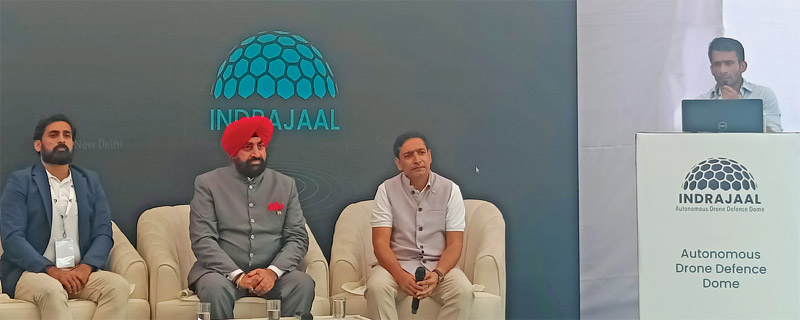Anti-drone system driven by artificial intelligence capable of thwarting threats in short time frame
Mohammad Asif Khan
In a significant technological stride, Grene Robotics, headquartered in Hyderabad, has introduced Indrajaal—an autonomous anti-drone system driven by artificial intelligence. This cutting-edge technology aims to fortify critical installations, urban centres and expansive regions against a diverse spectrum of drone threats, marking a notable advancement in India’s defence capabilities.

A live demonstration showcased Indrajaal’s prowess on the outskirts of Hyderabad. This system, heralded as the world’s first wide-area Counter-Unmanned Aircraft System (C-UAS), offers an integrated security solution against dynamic threats that static defences cannot effectively combat. The system’s unique LEGO-like combination mechanism incorporates 12 layers of cutting-edge technology, all driven by artificial intelligence.
Grene Robotics founder Kiran Raju emphasised that Indrajaal provides comprehensive 360-degree protection, encompassing detection, identification, classification, tracking and real-time neutralisation of threats. The system is capable of thwarting threats within a remarkably short time frame, ranging from 30 seconds to a few minutes.
Indrajaal’s ambit is vast, covering an expansive area of 4,000 sq kms. It is engineered to defend against a wide spectrum of autonomous drones, ranging from low radar cross-section (RCS) threats to medium and high-altitude long endurance (MALE and HALE) UAVs, loitering munitions, smart bombs, rocket showers, nano and micro drones, swarm drones, and more.
Growing threats
Lt Gen. Gurmit Singh (Retd), Uttarakhand governor and former deputy chief of army staff, commended Indrajaal as a futuristic solution to India’s security challenges. He pointed to the escalating hostile UAV activity in recent years, noting the increased attempts to infiltrate Indian borders, conduct reconnaissance and even drop contraband materials.
Lt Gen. Singh hailed the system as a groundbreaking advancement in defence technology that promises to redefine the security landscape for defence, public and private infrastructure. He stressed the system’s importance, stating: “This system not only enhances our nation and self-reliant military capabilities but also addresses the urgent need to defend against the increasing drone threat.”
In 2020, there were 76 reported cases of hostile UAV activity in India. This number surged to 109 in 2021 and 266 in 2022. The first eight months of 2023 have already seen 200 reported incidents, underscoring the pressing need for robust counter-measures.
Force was present at the launch of Indrajaal on September 2 in Hyderabad, where Raju underscored the critical role of artificial intelligence in modern warfare.
He stated: “In this era of modern warfare, only AI can beat AI.” Raju confidently asserted that “Indrajaal is well-equipped to address any drone threat and is impervious to jamming by existing technology.”
Raju shed light on the cost-effectiveness of Indrajaal, comparing it to essential capital infrastructure expenses. He stated that for projects akin to the Telangana secretariat, which cost between ₹200-300 crore, implementing Indrajaal would require an investment of approximately ₹5 crore.
Wing Commander Sai Mallela (Retd), co-founder of Grene Robotics, highlighted the limitations of current deployments, emphasising the shortcomings of stand-alone systems. Traditional radar-based detection struggles with accuracy, particularly against low RCS threats near the ground. He also underscored the inefficacy of existing point defence-based anti-UAV systems against moving targets like drones.
Countering drones
India is developing a range of counter-drone systems to protect its citizens and critical infrastructure from the growing threat of drones. These systems are being developed by the Indian government, private companies and research institutions.
One of the key programmes is the Drone Detection and Destruction System (DDDS), which is being developed by the Defence Research and Development Organisation (DRDO). The DDDS is a mobile system that can detect and jam drones and can also be used to launch interceptors to destroy drones.
Another key programme is the Drone Jammer, which is a device that emits a signal that can interfere with the signal that controls a drone, causing it to lose control and crash. Drone jammers are being developed by some Indian companies, including Bharat Electronics Limited (BEL) and Zen Technologies.
Indrajaal’s versatility allows deployment in various settings, including airports, military bases and critical infrastructure. Its user-friendly interface makes it suitable for both civilian and military applications.
The creators of Indrajaal are confident about its ability to safeguard critical installations, international borders and high-density areas. The system’s adaptability makes it a viable defence against UAVs, low RCS missiles, smart munitions and swarm drones. As drone activity is set to surge, Indrajaal’s unique ability to distinguish between friend and foe is poised to be a game-changer.

